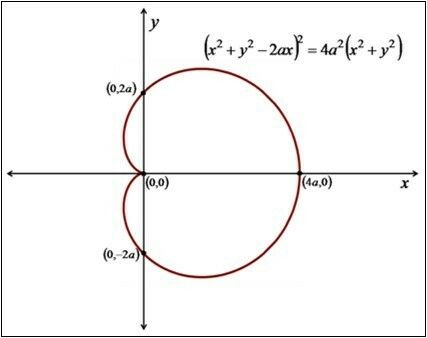Cardioid

The graph of the curve called the Cardioid is shown to the left along with its equation.
The word cardioid is from the Greek root cardi, meaning heart; hence cardioid means heart-shaped. In actuality, to my eye, the Cardioid looks more like a kidney shape then a heart (maybe it should have been named the Renaloid—in fact, there is a curve called the Nephroid that I will probably have constructions for in the future). More details about the Cardioid can be found in my book Playing with Dynamic Geometry, Chapter 6.
There are many different ways to generate a Cardioid, the most common of which is as the trace of a point on the circumference of a rolling circle that rolls on the outside of a stationary circle of equal radius. The animations below are presented in pairs. The first of the pairs is the basic geometric construction that either generates the Cardioid or demonstrates one of its properties. The second of the pairs is my “artistic” rendering based on that basic construction.
The word cardioid is from the Greek root cardi, meaning heart; hence cardioid means heart-shaped. In actuality, to my eye, the Cardioid looks more like a kidney shape then a heart (maybe it should have been named the Renaloid—in fact, there is a curve called the Nephroid that I will probably have constructions for in the future). More details about the Cardioid can be found in my book Playing with Dynamic Geometry, Chapter 6.
There are many different ways to generate a Cardioid, the most common of which is as the trace of a point on the circumference of a rolling circle that rolls on the outside of a stationary circle of equal radius. The animations below are presented in pairs. The first of the pairs is the basic geometric construction that either generates the Cardioid or demonstrates one of its properties. The second of the pairs is my “artistic” rendering based on that basic construction.
